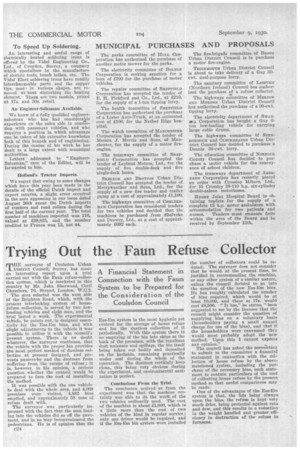Trying Out the Faun Refuse Collector
Page 46

If you've noticed an error in this article please click here to report it so we can fix it.
THE surveyor of Coulsdon Urban District Council; Surrey, has made an interesting report upon a trial carried out with the Faun refuse-collection system, which is marketed in this country by Mr. John Sherwood, Cecil Chambers, 76, Strand, London, W.C.2.
The arcs selected was the west side of the Brighton Road, which, with the present interlocking system of houserefuse collection, is served by two lowloading vehicles and eight men, and the trial lasted a week. The experimental vehicle, he points out, is designed essentially for the Ess-Em bins, and with alight adjustments to the vehicle it was possible to utilize it with the council's present system. There is no doubt whatever, the surveyor continues, that the vehicle with the proper bin provides the most perfect method of dustless collection at present designed, and prevents passers-by and the dustmen from suffering from the escape of refuse ; it is, however, in his opinion, a serious question whether the council would be prepared to facethe cost of installing the method.
It was possible with the one vehicle to deal with the whole area, and 4,069 premises were visited, 4,883 bins emptied, and approximately 58 tons of refuse dealt with.
The surveyor was particularly hapressed with the fact that the men loading into the vehicles did so off the pavement, and in no Way inconvenienced the pedestrians. He is of opinion that the
Ess-Em system is the most hygienic yet evolved for the storage of house refuse and for the dustless collection of it periodically. With this system there is no emptying of the bin into skips at the back of the premises, with the resultant dust nuisance and spillage, the bin itself being taken out bodily and deposited on the kerbside, remaining practically under seal during the whale of the operation. The dustmen certainly keep clean, this being very obvious during the experiment, and environmental sanitation is perfect.
Conclusions From the Trial.
The conclusion arrived at from the experiment was that the machine certainly was able to do the workof the two vehicles ordinarily used. The cost of the machine is about £1,600, which is a little more than the cost of two vehicles of the kind in regular service.; only one driver would be required, and if the Ess-Em bin system were installed the number of collectors could be reduced. The surveyor does not consider that he would, at the present time, be justified in recommending the machine, or any other system of a similar nature, unless the council decided to go into the question of the new Ess-Em bins. He has roughly calculated tne number of bins required, which would be at least 10,000, and these at 17s. would cost £8,500. " It has," he states, "been suggested to me by the licensee that the council might consider the question of supplying bins on a voluntary basis (householders paying a small annual charge for use of the bins), and that if the householders were canvassed they would most probably adopt the new method. Upon this I cannot express any opinion."
The council has asked the accountant to submit to the committee a financial' statement in connection with the collection of house refuse by the abovementioned system, including the purchase of the necessary bins, such statement to contain particulars of the cost of collecting house refuse by the present method so that useful comparisons may be made.
One of the advantages of the Ess-Ern system is that, the lids being always upon the bins, the refuse is kept very much drier, being protected against rain and dew, and this results in a reduction in the weight handled and greater efficiency in destruction of the refuse in furnaces.












































































































